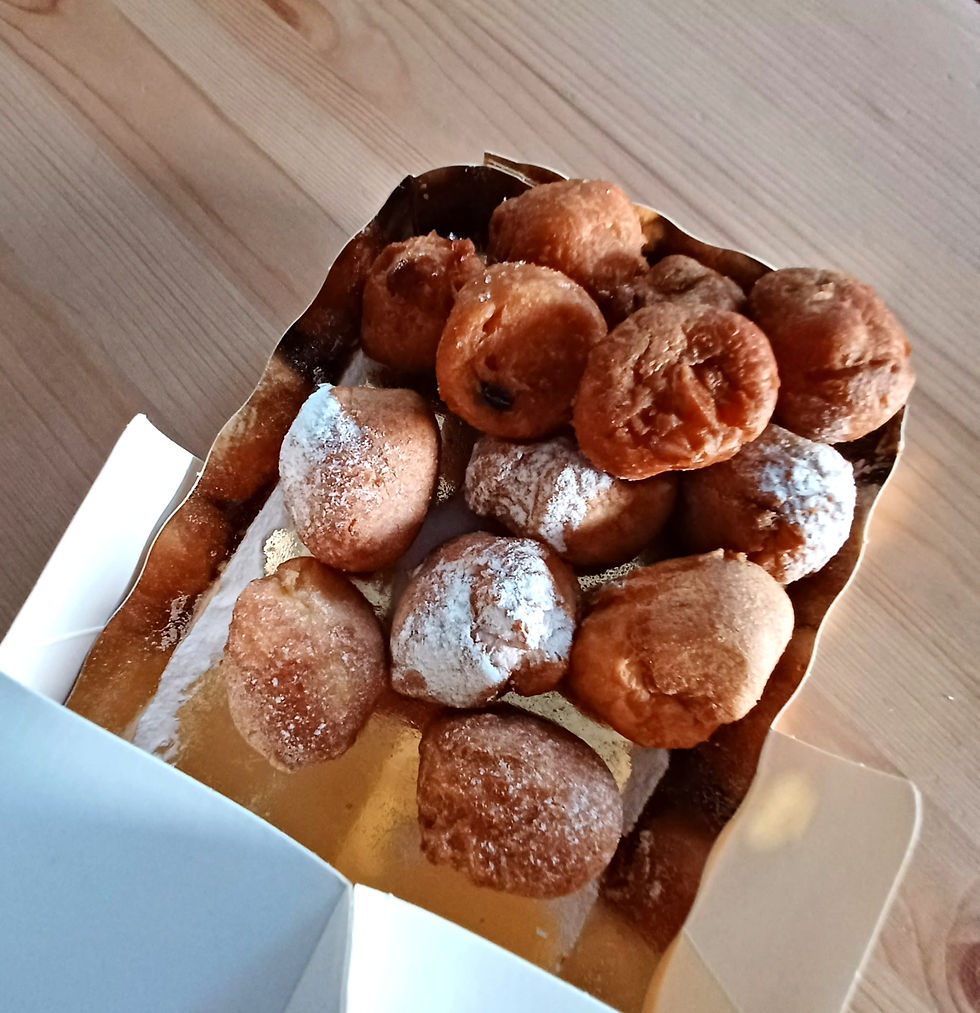Frittelle - Venice's Favourite Carnival Treat
- Mangia Mangia

- Feb 9, 2024
- 4 min read
Updated: Sep 17, 2024
We're in full Carnival swing!
So, what are we eating?

Carnival is more of a time than a day.
With excitement building from the beginning of the new year, February is known as Carnival Month in Italy so we're busy enjoying the most deliciously indulgent of dolcetti - Frittelle.
In Veneto, where Venice Carnival is a winter extravaganza, there are two main contenders for Carnival treats, Frittelle and Crostoli.
Both deep-fried but very different, you'll spot the appearance of these Carnival favourites throughout the region in supermarkets, patisseries and bakeries as soon the Christmas decorations come down on the Epiphany, 4th of January. We may enjoy a casual frittella here and there in January, but when Carnival Month rolls around, we're indulging in our favourites with regular gusto until it all ends on Shrove Tuesday in a flourish of confetti, masks, costumes and street parades. If you're lucky enough to experience Carnival in Venice, make sure to find a spot on Piazza San Marco to witness the iconic flight of the Carnival Angel!

What are Crostoli?
'These are also deep fried, but instead of soft, doughy balls, crostoli are crispy and flat. Made in different shapes and called different names throughout Italy - Frappe, Chiacchiere, Bugie, Cenci, Sfrappole, in Naples they're dipped in a rich chocolate cream called sanguinaccio, as it contains pig's blood.'
From our Blog Post: Carnevale - A Time of Raucous Indulgence
What's a Frittella?
From the Italian for 'fried' - fritto, these palm-sized dumplings are essentially a type of doughnut. A dough of wheat flour, eggs, sugar and yeast is spooned into hot oil and then typically stuffed with a filling, and here's where the party gets started...
Whilst frittella fillings traditionally include crema (custard cream), Nutella, whipped cream or zabaione (an egg-based boozy crema with Marsala liqueur), every Carnival that comes around brings something new - apple, crema di pistacchio, lemon or dark chocolate - we're never getting bored of these 'spongy inside but crispy outside' delicacies!

The Origins of Frittelle
Considered 'Capital of Italian Carnival' (by the Venetians of course), it's natural they claim the origins of the frittella. These Carnival favourites are found mainly in Venice's region of Veneto so story goes that they were first made here in the 8th century even if little balls of fried dough called frictilia were also a thing in Ancient Rome. Back in the 17th century, every quarter of Venice had its own fritelero whose job was to sell freshly-fried frittelle di Carnevale to passers-by from their pop-up. Their recipes were handed down to their children, as was their business, and so the tradition continued.
The first Frittelle di Carnevale were made with dried fruit to add flavour and dusted in icing sugar, these can still be found in Venice called fritole. The rest of Italy calls them zeppole and makes them according to regional preferences - in Naples, they're made for Father's Day with custard crema and called Frittole di San Giuseppe.

Types of Frittelle
One of the first questions you'll be asked when purchasing a tray of frittelle (outside of Venice) is, "Con o senza uvetta?" - 'With or without raisins?' Much like panettone at Christmas - with or without canditi?
But on the island, there's only one true type and that's the classic fritola veneziana made with raisins, pine nuts, orange peel and a local liqueur like grappa. These are Venice's favourite Carnival treats which are lovingly made at home by le mamme as soon as Carnival month comes around.
Castagnole are another ancient Carnival dolcetto here in Venice. These were originally baked but now are deep-fried and even if the dough sounds similar to that of the frittella, castognole are smaller, harder and never filled, they're named after the chestnut.
An interesting version, if you ever get the chance, is the apple frittella - slices of apples, battered, fried and dusted in sugar - deliziose!
In Venice's oldest of pastry shops, Dal Nono Colussi, fritole are still made col buso - with a hole, just as they were in the 600s when they were sold by the frittelle-sellers on a stick. You'll find fritole veneziane all over the city during the period of Carnival, some patisseries refuse to make anything else out of tradition and principle so if you're after the gorgeous version with a filling, Majer has pastry shops dotted all about with a huge range! We say, "Pick one of each!"

Don't expect to pay more than €2 for this gooey, moreish Carnival treat and do what the Venetians do - pop into a pastry shop on your way to wherever you're going and grab a tray,we're all expecting one...
Make the most of Carnival decadence while you can because after these heady days of indulgence, along comes the gran finale of Shrove Tuesday - Martedi Grasso (Mardi Gras or Pancake Day) and all festivities, including frittelle, disappear from Ash Wednesday until next year.
Find the recipe for Frittelle alla Veneziane in our new cookbook Appetito ❤️
Buona frittella amici and happy Carnival!










Comments